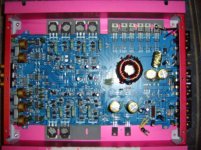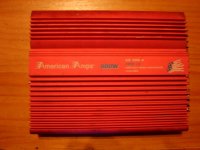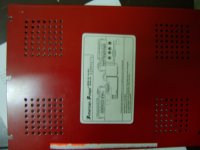Hi All
I was given this amplifier to repair and discovered why the protection light remained on. Turned out to be a bank of Power MOSFETS in the amp section that had shorted.
to repair and discovered why the protection light remained on. Turned out to be a bank of Power MOSFETS in the amp section that had shorted.
The problem is that I have no way of identifying these parts as their numbers were ground of, probably by the manufacturer. I have taken photos of the amp and would be most grateful if anyone is able to assist. The amp is called American Amps model AA200.4
PS. I do not have a schematic for this amp either which makes it even worse.
I was given this amplifier
 to repair and discovered why the protection light remained on. Turned out to be a bank of Power MOSFETS in the amp section that had shorted.
to repair and discovered why the protection light remained on. Turned out to be a bank of Power MOSFETS in the amp section that had shorted.The problem is that I have no way of identifying these parts as their numbers were ground of, probably by the manufacturer. I have taken photos of the amp and would be most grateful if anyone is able to assist. The amp is called American Amps model AA200.4
PS. I do not have a schematic for this amp either which makes it even worse.
Attachments
Do not think they are mosfets
Hi,
Archimeds, it seems to me that they are not mosfets. Probably they are BJT transistors. The parts may be 2SA1695/C4468 complements. I do not know your amplifier model nor I have shematic of it. But, many of this kind of amplifiers uses the BJT transistors, i wrote above. If u can not find original replacements, U can use TIP35/36 pairs by replacing the driver BJTs. But, at first you should make a basic measurement, to be sure if they are mosfets or BJTs. Please make a measurement with your multimeter's rectifier mode. Measure the output Transistors' 1 to 3 and 1 to 2 legs(from left to right). If you see ~0.6V we can be sure that they are BJTs. If my assumption is true U can use original replacements (1695/4468). Otherwise if they are really mosfets you should need a real help for the shematic of amplifier.
Good luck
Hi,
Archimeds, it seems to me that they are not mosfets. Probably they are BJT transistors. The parts may be 2SA1695/C4468 complements. I do not know your amplifier model nor I have shematic of it. But, many of this kind of amplifiers uses the BJT transistors, i wrote above. If u can not find original replacements, U can use TIP35/36 pairs by replacing the driver BJTs. But, at first you should make a basic measurement, to be sure if they are mosfets or BJTs. Please make a measurement with your multimeter's rectifier mode. Measure the output Transistors' 1 to 3 and 1 to 2 legs(from left to right). If you see ~0.6V we can be sure that they are BJTs. If my assumption is true U can use original replacements (1695/4468). Otherwise if they are really mosfets you should need a real help for the shematic of amplifier.
Good luck
Hi Whortless
Thanks for the reply and advice.
I have already done those tests by removing a transistor from the other bank(that is working) and testing it to see if it is a BJT or MOSFET.
I do not measure .6V on from 1(B) to 2(C) or 1(B) to 3(E). The absence of the bias transistor on the heatsink as well as the small size of the driver transistors indicates to me that this is a MOSFET amp. It looks like some type of Fairchild Complementary MOSFET.
Thanks for the reply and advice.
I have already done those tests by removing a transistor from the other bank(that is working) and testing it to see if it is a BJT or MOSFET.
I do not measure .6V on from 1(B) to 2(C) or 1(B) to 3(E). The absence of the bias transistor on the heatsink as well as the small size of the driver transistors indicates to me that this is a MOSFET amp. It looks like some type of Fairchild Complementary MOSFET.
Although anything is possible, I really doubt that the amp is using FETs in the output stage.
There are many amps that don't use bias transistors. They operate as class B amps with no bias current.
Do you not get any readings from pin 1 to pin 2 (on both ohms and diode check) no matter the lead placement?
There are many amps that don't use bias transistors. They operate as class B amps with no bias current.
Do you not get any readings from pin 1 to pin 2 (on both ohms and diode check) no matter the lead placement?
Hi Perry
Nice to hear from you.
I have tried swapping leads around (PNP,NPN) to take measurements but they did not show. I took out the transistor and tried measuring the HFE on the multimeter and this did not help either.
I will have another go later on this evening and will post my findings.
thanks
Nice to hear from you.
I have tried swapping leads around (PNP,NPN) to take measurements but they did not show. I took out the transistor and tried measuring the HFE on the multimeter and this did not help either.
I will have another go later on this evening and will post my findings.
thanks
Hi,
It is interesting. Two weeks ago I repaired one of my friend's amplifier, named Grunberg(4*200W). The inside of the amplifier was very similar to yours and it was using the BJT pairs i told before. I replaced rear outputs' BJTs with A1943/C5200 pairs to use it in a stable 4ohm bridge application and the amplifier is wery well now. But, this is not the solution of your problem. There are many choises in TO247 pacage to use as output devices. SJ/SK or IRFP*/IRFP9*. If they are labeled as Fairchild, please check the Fairchild's web site for power mosfets. Last week I bought 4 IRFP150 labeled as Intersil product and have look the complementary pair but they do not producing IRFP9150. Therefore, I think you can decide which mosfets could be your amplifier's output transistors(probably they are IRFP240/9240 but, they can not be work in 2ohm in such kind of an amplifier).
On the other hand your outputs may be darlington complementary pairs. To check this please measure the C-E legs in reverse polarity. Although some darlingtons include diodes but, mosfets always include body diodes.
Regards
It is interesting. Two weeks ago I repaired one of my friend's amplifier, named Grunberg(4*200W). The inside of the amplifier was very similar to yours and it was using the BJT pairs i told before. I replaced rear outputs' BJTs with A1943/C5200 pairs to use it in a stable 4ohm bridge application and the amplifier is wery well now. But, this is not the solution of your problem. There are many choises in TO247 pacage to use as output devices. SJ/SK or IRFP*/IRFP9*. If they are labeled as Fairchild, please check the Fairchild's web site for power mosfets. Last week I bought 4 IRFP150 labeled as Intersil product and have look the complementary pair but they do not producing IRFP9150. Therefore, I think you can decide which mosfets could be your amplifier's output transistors(probably they are IRFP240/9240 but, they can not be work in 2ohm in such kind of an amplifier).
On the other hand your outputs may be darlington complementary pairs. To check this please measure the C-E legs in reverse polarity. Although some darlingtons include diodes but, mosfets always include body diodes.
Regards
Hi Guys
I have retested the other bank of transistors and they have checked out to be BJT's. I must have tested the extracted faulty devices and mixed them up the first time around.
This has to be the most crappy amplifier I have ever seen. I injected a pure sine wave in and measured the output on the 2 working channels. What I saw was not a pure sine wave but something distorted between a sine and a triangle wave on the outputs and this was at both low and high volume.
Thank GOD I don't own this piece of crap.
I just like to say thanks to both Whortless and Perry for your inputs.
I have retested the other bank of transistors and they have checked out to be BJT's. I must have tested the extracted faulty devices and mixed them up the first time around.
This has to be the most crappy amplifier I have ever seen. I injected a pure sine wave in and measured the output on the 2 working channels. What I saw was not a pure sine wave but something distorted between a sine and a triangle wave on the outputs and this was at both low and high volume.
Thank GOD I don't own this piece of crap.
I just like to say thanks to both Whortless and Perry for your inputs.
- Status
- This old topic is closed. If you want to reopen this topic, contact a moderator using the "Report Post" button.
- Home
- General Interest
- Car Audio
- Help needed in identifying MOSFETS


